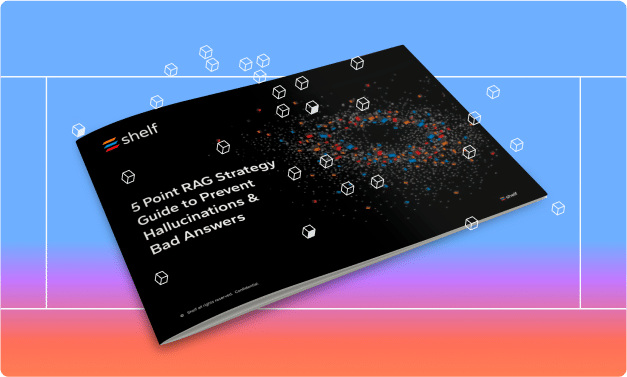Effective data management is crucial for the optimal performance of Retrieval-Augmented Generation (RAG) models. Duplicate content can significantly impact the accuracy and efficiency of these systems, leading to errors in response to user queries.
Understanding the repercussions of duplicate content is essential if you hope to mitigate potential issues that affect the model’s performance.
Let’s walk through the different ways duplicate content can manifest errors in RAG systems. These examples emphasize the importance of data quality and strong management practices.
1. Duplicate content causes confusion in training data
Duplicate content in the training data of a RAG system can cause confusion because it muddies the clarity of information the model is supposed to learn from. When a RAG system encounters multiple instances of the same or very similar data, it can have trouble distinguishing what makes each piece of data unique or important.
This blurring of distinct data points can lead the model to place undue emphasis on what appears to be critical information, simply because it shows up frequently. As a result, the model may develop a skewed understanding of the data, focusing too much on the repeated elements and potentially missing out on learning from more varied, unique data points.
This confusion can hamper the system’s ability to generalize from its training to real-world applications, where diverse and accurate responses are crucial.
Example
Prompt: “What are the benefits of cloud computing?”
Error Scenario: Due to duplicative content in the training data, the model overemphasizes certain benefits like cost savings and scalability while neglecting other crucial aspects such as security and compliance.
2. Duplicate content leads to redundant information
The presence of duplicate information in a RAG system can significantly impair its ability to generate accurate and contextually appropriate responses. When multiple instances of similar content exist, despite slight variations in how they convey the same message, it challenges the model’s capacity to determine which piece of information is most relevant for a given query.
This scenario can confuse the model in two main ways. First, during the retrieval phase, the system might repeatedly select these similar yet distinct entries, thinking each provides unique value.
This can clutter the data pool from which the generator must choose, leading to a decision-making bottleneck. The model may waste computational resources evaluating minor differences among these entries instead of focusing on retrieving and integrating genuinely diverse and pertinent information.
Second, this redundancy affects the training of the model by reinforcing the same concepts repeatedly in slightly altered forms. As a result, the model might learn to overgeneralize, producing responses that are not only redundant but also lack nuance.
This overgeneralization can diminish the model’s effectiveness in real-world applications, where the ability to discern and articulate fine distinctions can be critical. Ultimately, the system’s output may become predictable and not finely tuned to subtle variations in user queries, reducing the overall utility and responsiveness of the model.
Example
Prompt: “Explain the role of artificial intelligence in healthcare.”
Error Scenario: The model generates redundant responses by repeating similar information on AI applications in diagnosis without addressing other critical roles like personalized treatment recommendations.

3. Duplicate content often includes inconsistencies
Duplicate content within the training data of a RAG system often includes inconsistencies that can severely compromise the model’s performance. When contradictory information appears across different instances of duplicate content, it poses a significant challenge for the model in terms of reliability and accuracy of its outputs.
This problem stems from the fundamental way RAG systems operate. They depend on retrieving the most relevant information to aid in generating responses. If the retrieved content is contradictory because of duplications with differing details or conclusions, the system faces a dilemma in deciding which piece of information to prioritize.
This conflict can force the model into making arbitrary choices about which data to trust, potentially leading to outputs that are inconsistent with each other or with reality.
Moreover, these inconsistencies can confuse the model during its learning phase, where it attempts to identify patterns and establish relationships between queries and appropriate responses. When faced with repeated contradictory data, the model may struggle to form a clear understanding of the correct information, resulting in a learning process that might reinforce incorrect responses.
Consequently, this can diminish the model’s ability to respond accurately and consistently in practical applications, reducing its overall effectiveness and trustworthiness.
Example
Prompt: “What are the impacts of climate change on agriculture?”
Error Scenario: Duplicative content containing conflicting information leads the model to provide inconsistent responses, alternating between stating increased yields due to longer growing seasons and decreased productivity due to water scarcity.
4. Duplicate patterns contribute to overfitting
Duplicate patterns can significantly contribute to overfitting, a scenario where the model learns specific patterns and noise in the training data at the expense of its ability to generalize to new, unseen data. This tendency is particularly problematic in systems designed to handle a wide range of inputs and generate diverse outputs.
When a RAG system encounters repeated or redundant patterns in its training data, it may start to memorize these patterns rather than learning to understand and apply the underlying principles that are essential for handling varied queries.
This memorization is akin to a student who learns answers by rote for a test rather than understanding the subject matter. They may perform well under familiar conditions but struggle when faced with questions that require a deeper understanding or a different application of knowledge.
As a result, the model’s ability to provide accurate and relevant responses to diverse or novel queries is compromised. In practice, this means that while the model might perform exceptionally well on training or similar data, its performance degrades when it encounters real-world data or queries that deviate from the patterns it has memorized.
This limitation is a significant drawback for RAG systems, which are expected to adapt and respond intelligently across a broad spectrum of topics and scenarios. Overfitting thus not only reduces the robustness of the model but also its usefulness in practical applications.
Example
Prompt: “How does machine learning work?”
Error Scenario: The model overfits on duplicated examples of supervised learning, failing to generalize the concept to unsupervised or reinforcement learning, resulting in incomplete and biased explanations.
5. Duplicate content reduces accuracy
Duplicate content can dilute the relevance of unique data points, leading to a reduction in the accuracy of the model’s responses. This occurs because multiple versions of the same or very similar information can overwhelm and confuse the retrieval process.
When a RAG system is trained with a dataset that contains numerous instances of duplicated content, it may find it challenging to distinguish which pieces of information are the most relevant or current for a given query.
This challenge arises because the system’s retrieval component, designed to fetch pertinent information to assist in generating responses, may become biased towards selecting duplicated content. Such content often appears more frequently in searches simply due to its volume, rather than its relevance or accuracy.
This situation compromises the model’s ability to prioritize and utilize the most appropriate and up-to-date information. Consequently, the responses generated can be less accurate, as they might be based on outdated or less relevant versions of duplicated data rather than the most current and precise information available.
Example
Prompt: “Discuss the evolution of e-commerce.”
Error Scenario: Duplicative content on early online payment systems dominates the dataset, causing the model to overlook significant advancements like mobile commerce and social media integration, leading to outdated and incomplete responses.

6. Duplicate content increases processing time
Duplicate content in a RAG system increases the computational load, which in turn impacts the system’s response times. This increase in processing time arises because the system must handle and sift through redundant information during both the retrieval and generation phases.
When a RAG system retrieves information to aid in generating responses, it typically searches through a vast dataset to find the most relevant content based on the user’s query. If this dataset contains a high volume of duplicate content, the retrieval process becomes less efficient.
In these cases, the system expends additional computational resources to process and distinguish between these redundant entries, trying to determine which pieces are most pertinent. This not only slows down the retrieval process but also burdens the subsequent generation phase, as the model might need to integrate and synthesize information from unnecessarily large pools of similar data.
The increased processing time reduces the system’s overall efficiency and can lead to slower response times, potentially frustrating users and diminishing the practical utility of the system in environments where speed and accuracy are critical.
Example
Prompt: “Explain the concept of Big Data analytics.”
Error Scenario: Processing redundant information on data volume overwhelms the system, delaying response generation and causing the model to provide delayed and slow responses to user queries.
7. Duplicate content leads to difficulty in learning
Duplicate content can hinder the model’s learning capabilities, particularly its ability to recognize new patterns and adapt to different query contexts. When a dataset is saturated with duplicative content, the model’s exposure to a diverse array of information is limited, which is crucial for developing a robust understanding of various subjects and scenarios.
This dominance of duplicate content causes the model to repeatedly encounter the same or similar information, leading to a skewed learning process where the model may overemphasize certain patterns that are frequently represented.
Consequently, this repetition restricts the model’s ability to identify and abstract underlying patterns that are essential for responding effectively across a broader range of queries. The model, thus, becomes less adept at generalizing from its training to novel situations, which is a key attribute of successful AI systems.
Furthermore, the lack of diverse examples can impair the model’s capability to fine-tune its responses based on subtle differences in context or intent of the queries. This difficulty not only impacts the accuracy but also the relevance of the responses generated, making the system less effective in practical applications.
Example
Prompt: “How can AI be used in customer service?”
Error Scenario: Duplicated content on chatbot applications dominates the dataset, hindering the model’s ability to learn about AI-driven sentiment analysis or personalized recommendation systems, limiting its response diversity.
8. Duplicate content creates a negative user experience
Repetitive responses generated by a RAG system, due to duplicative content in its training dataset, can lead to significant frustration among users and adversely affect their engagement with the system.
When users pose queries to a RAG system, they expect precise, insightful, and contextually appropriate answers. However, if the system is trained on a dataset with high levels of duplicate content, it tends to produce responses that are not only repetitive but may also be irrelevant to the specific needs or context of the user’s question.
This repetitiveness can quickly erode user trust and confidence in the system’s capabilities, as it fails to provide the varied and accurate information that users seek.
The impact of such negative experiences is twofold. Firstly, it diminishes user satisfaction, as the responses do not meet their expectations or solve their queries effectively.
Secondly, it leads to decreased user engagement, as users are less likely to return to or rely on a system that consistently provides unsatisfactory answers.
Example
Prompt: “Recommend a good book on machine learning.”
Error Scenario: Repetitive responses recommending the same introductory machine learning textbook frustrate users seeking diverse recommendations, leading to disengagement and dissatisfaction with the system.
9. Duplicate content heightens the risk of incorrect responses
Duplicate content heightens the risk of the model providing incorrect or outdated information in its responses. This issue arises when the duplicate content includes errors, inaccuracies, or outdated facts, which, when repeatedly encountered by the model during training, may become reinforced as correct or relevant.
Since RAG systems rely heavily on the quality and accuracy of the data they retrieve to generate responses, the inclusion of erroneous duplicative content can lead to a systemic issue where these inaccuracies are perpetuated in the outputs.
For instance, if the system repeatedly retrieves and processes duplicate entries that contain factual errors or outdated information, it may mistakenly learn to recognize these inaccuracies as true. Consequently, the model may continue to reproduce these errors in its responses to user queries, leading to the dissemination of misinformation.
Such propagation of incorrect information can have serious implications, especially in scenarios where accurate data is critical, such as in medical, financial, or emergency-related contexts. Users relying on the system for precise and up-to-date information may be misinformed, which not only undermines the credibility of the system but also poses risks to users who may make decisions based on this flawed output.
Example
Prompt: “What are the key features of the latest smartphone model?”
Error Scenario: Duplicate content containing outdated specifications misleads the model to provide incorrect information on the smartphone’s camera capabilities and storage capacity, leading to misleading responses for users.

10. Duplicate content leads to challenges in data maintenance
The presence of duplicative content can lead to a variety of issues that compromise system performance, as previously discussed, such as reduced accuracy, increased processing times, and potential misinformation.
To mitigate these problems, continuous and rigorous data maintenance practices are essential. This involves deploying sophisticated algorithms or manual review processes to scan through large datasets, identify duplicates, and ensure that only unique, relevant, and accurate information is retained.
However, this constant need for data cleaning can divert resources away from other critical tasks such as system development and improvement, thereby affecting the overall productivity of the team managing the RAG system. Moreover, the ongoing requirement to monitor and update the dataset to prevent the accumulation of duplicate content can lead to higher operational costs and complexity.
Example
Prompt: “Explain the impact of blockchain technology on supply chain management.”
Error Scenario: Difficulty in identifying and removing duplicate content on blockchain applications results in inconsistent and conflicting information in the model, highlighting the challenges in data cleaning and maintenance for ensuring accurate responses.
Take Duplicate Content Seriously
If you hope to leverage the benefits of RAG systems, it’s important to recognize the impact of RAG systems. By addressing challenges of duplicative content through strong data management practices, you can enhance the accuracy, efficiency, and user experience of your AI applications. Prioritizing data quality and maintaining a clean dataset play a critical role in optimizing the performance of AI systems and improving the reliability of responses.




